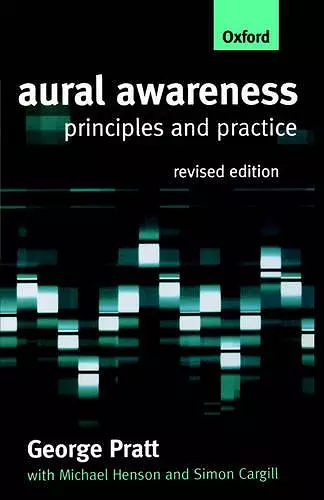Aural Awareness
Principles and Practice
Michael Henson author George Pratt author the late Simon Cargill author
Format:Paperback
Publisher:Oxford University Press
Published:21st May '98
Currently unavailable, and unfortunately no date known when it will be back

Traditional aural training is heavily biased towards the perception and identification of pitch and rhythm. But George Pratt argues in this book that in these days of CDs and cassette recorders much of this area of the subject can best be worked on alone. He demonstrates how, by tailoring tasks to individual needs, every student can make some encouraging progess in these aspects of music. But this also makes time available for developing the perception of other musical elements just as significant yet often neglected because of their more abstract and qualitative nature--elements such as timbre, texture and density; compass, range, and tessitura; dynamics and articulation; ordering music in structures and placing it in space. The chapters on these areas break new ground. They demonstrate how these `elements', once perceived and analysed, are incorporated into the skills which musicians need--to notate sound quality accurately, to read or `image' the implications of notation beyond though including pitch and rhythm; to play and sing by ear; to improvise and to memorize, not only 'right notes' but the subtle qualities and nuances which bind them into coherent music. This book was first published by Open University Press, and at that stage was primarily addressed to groups of music students and their teachers, in universities, colleges, conservatoires, and sixth forms. But, by a happy accident of timing, George Pratt was then invited to be a member of the National Curriculum Music Working Group, and many of the ideas here, in particular the identification and codification of musical 'elements', were fed into their thinking. The present book has been substantially revised to take account of what are now the statutory requirements of the National Curriculum in Music. Much of the material in it is either already accessible for pupils in the earlier years at school or is easily adapted by imaginative teachers. In addition, every section leads towards open-ended `do-it-yourself' exercises and experiments which can be used by individuals. This follows the pattern established in Professor Pratt's The Dynamics of Harmony: Principles and Practice (OUP, 1996), and is designed to encourage open-ended exploration generated by musicians's individual needs and enthusiasms. This freedom to adapt exercises includes using them in any musical context. Timbre is as important to a rock group...
...an ideas book, a practical handbook for the classroom or studio....the material is presented in an engaging and unpretentious manner and enlivened with the occasional dash of humor. * Music Perception *
ISBN: 9780198790211
Dimensions: 217mm x 138mm x 10mm
Weight: 227g
164 pages
Revised edition